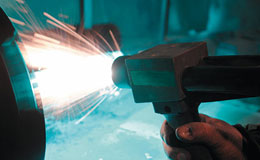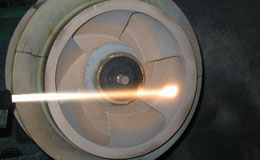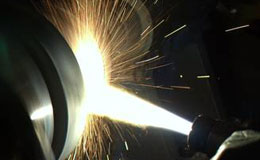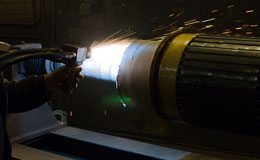Metalizing

Metalizing or “thermal spraying” involves projecting small molten particles onto a prepared
surface where they adhere and form a continuous coating. Upon contact they mechanically
bond to the substrate and then onto each other. The heat energy in the molten particles is
relatively small to the size of the sprayed component so the process imparts very little
heat to the substrate. As the temperature increase of the coated parts is minimal, heat
distortion is not normally experienced. This is a major advantage over welding or
hot-dipped galvanizing. We utilize three different Metalizing processes depending on your
specific needs. The following is further explanations of the processes.
HVOF (High Velocity Oxygen Fuel)

High velocity oxygen fuel (HVOF) systems use a high velocity jet into which the spray
powder particles are injected, the jet being formed by the combustion of oxygen and fuel,
which is heated and accelerated towards the component being thermal spray coated.
HVOF coatings are very dense, strong and show low residual tensile stress or in some
cases compressive stresses, which enable thick coatings to be applied in comparison
with other metalspray processes. The very high kinetic energy of particles striking the
substrate surface does not require the particles to be fully molten to form high quality
HVOF coatings. This is certainly an advantage for the carbide cermet type of HVOF coatings.
HVOF coatings are used in applications requiring the highest density and strength not
found in most other thermal spray processes. New applications are being discovered,
including as a Chrome Plating replacement.
View Info Graphic of HVOC
Plasma Spray

Plasma is a term to describe gas, which has been raised to such a high temperature
that it ionises and becomes electrically conductive. During atmospheric plasma arc
spraying, the plasma is created by an electric arc burning within the nozzle of a plasma
spray gun. The arc gas is formed into a plasma jet as it emerges from the nozzle. Powder
particles are injected into the jet where they melt and are then transferred to the substrate
at high velocity, producing a strongly adherent coating. Almost any material can be plasma
sprayed including metals, ceramics and plastics. The very high plasma temperature
(about 12000 °C) tends to produce higher oxide contents in the coating than are typical
of HVOF coatings. The plasma spray process is also sometimes referred to as low-pressure
plasma spray. Because of the high temperature and high thermal energy of the plasma jet,
materials with high melting points can be sprayed, with plasma spraying widely applied in
the production of high quality sprayed coatings.
View Info Graphic of Plasma Spray
Wire Arc Spray

The Wire Arc Spray process, sometimes referred to as "twin wire arc spraying", uses
two wires, which are melted by an electric arc. The molten material is atomized by
compressed air and propelled towards the substrate to be coated.
View Info Graphic of Arc Spray
Each of the processes is unique and offer something different depending on the application,
here at Ohio Metal Spray we draw on our years of experience and our “No Nonsense” approach
to providing you with the best coating for your needs and never something that you don’t.